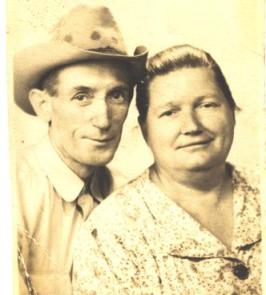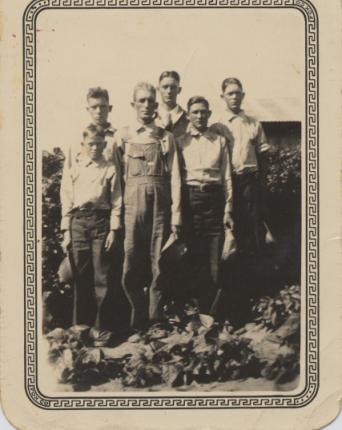John Dudley Keys and Minnie Allice Holland

John and Minnie Keys raised eleven children in a two room cabin, "Old Home", down the old Qualls road in the Cookson Hills of Oklahoma, Cherokee Nation West.
|
|
The Son of James Theodore Keys and Margaret Carlile:
9. JOHN DUDLEY KEYS (A-Ni-Wa-Yah, Wolf Clan) married MINNIE ALLICE HOLLAND. |
Children of Minnie & John Dudley Keys

Standing:
Mary, Clint, Ellis, Nina, Levi and Knox
Kneeling:
Rabbit, Walt and Cookson

Back Row:
Rabbit, Knox and Levi
Front Row:
Guy, their father John, and Walt
During the depression years John and the boys would go up around Porter and pick cotton. John cut railroad ties and hickory billets for the railroad, getting anywhere from 10 to 50 cents a piece for them. They never went hungry as Minnie had her garden and plenty of hands to tend it. She insisted there not be one weed in it... not even in the cornes.
|
Making a living was difficult at best. Money was always hard to come by. The "Indian" land John received was next to worthless, ten acres of rocks and ravines, not fit for farming. He rented a place not far from his folks. In later years they would call it "Old Home". Way too small for the thirteen people who lived there, Minnie would hang sheets at night between the beds for privacy. School was down toward Qualls. They called it "Stone Chapel". |
|
John's Uncle Henry's boy, Kye Carlile had other ideas about how to make a living. Some say he robbed banks with Pretty Boy Floyd, another local boy from over in Cookson. Some said he killed a woman, but he swore he didn't kill anyone. One time he came down to John and Minnie's place for a visit. He played ball with the boys, running through the pasture barefoot. He got thirsty so he went down to the creek to get a drink of water. Guy stopped him saying, "Mister, I don't believe I'd drink right there." When Kye ask him why he said "`Cause there´s an old dead crawdad right over there". Kye laughed about that the rest of the day. |
|
The older boys left home after returning from the CC camps. Yowner and Knox married, Rabbit, Levi and Walt went out on their own. Guy had gone to the CC camps in Colorado a little later than the older boys and then went on his own. Mary, Ellis, Nina, Cookson and Clint were all that were home in the years preceding World War II. |
Clyde Welch and Nina Elizabeth Keys
 On one of those trips into town, Nina saw a handsome young man of about sixteen. He was the most handsome boy she'd ever seen and as it turns out, no relation to her. That in its self was somewhat of a miracle as everyone it seemed was related to her in one way or another. Of course, he never even looked her way but thats not the last she would see of CLYDE L. WELCH...
On one of those trips into town, Nina saw a handsome young man of about sixteen. He was the most handsome boy she'd ever seen and as it turns out, no relation to her. That in its self was somewhat of a miracle as everyone it seemed was related to her in one way or another. Of course, he never even looked her way but thats not the last she would see of CLYDE L. WELCH...
~ ~Cherokee Blessing~ ~
Yagaquu osaniyu advanto adadaligi ngohili nasquv utloyasdi nihi. Which means:
May the blessings of the Great Spirit be always with you!
Sources and Acknowledgements | |||
|
|
|
|
|
|
|
|
|
|
|
|
|
|
|
|
|
|
|
|
|
|
|
|
|
|
|
|
|
Books:
HISTORY OF THE CHEROKEE INDIANS by Emmet Starr |
 I want to thank Yogi for this beautiful award.
I want to thank Yogi for this beautiful award.
Thanks, Doc!
|
|
|